Keep reading to learn how you can master your virtual presence, from attire to lighting.
Wardrobe and Attire Guidelines:
Professional Appearance: Dress in professional attire that is well-fitted, clean, and appropriate for business settings.
Solid Colors: When preparing to be on camera, we suggest participants to choose clothing options that feature solid colors or subtle patterns. Tightly spaced patterns can result in the unwanted occurrence of a moiré pattern when captured on camera.
Grooming: Maintain well-groomed hair, and consider makeup and/or self-care practices that enhance your appearance on camera.
Additional Makeup Tips for Women: Keep makeup natural looking and avoid looks that will appear heavy such as an intense smoky eye, and dark lipstick shade. The camera picks up more than you think and favors neutral shades and pallets. Pink lipstick shades or a red that suits your skin tone shows up nicely under the lights. Overall, be sure to use matte and neutral hues. Avoid high-shine that is commonly found in blushes, lip glosses, and eye shadow. Accentuate your features so that they do not become lost or washed out when captured on camera.

Set and Background Guidelines:
Neat and Tidy Background: Choose a background that is free from clutter and well-organized. Eliminate visual distractions that could divert viewers' attention away from you. Ensure their focus remains on you rather than wandering around the room.
Avoid Backlighting: We never want to be sitting in front of bright windows that will cause us to be silhouetted and hard to see.
Supplementary Lighting: An essential aspect of your setup involves light sources that seamlessly integrate into your home or studio arrangement. This can be as straightforward as a light positioned on a stand behind your computer monitor. It's important to have the flexibility to easily diffuse the light or adjust its intensity as needed.

Camera Guidelines:
Eye-Level Camera: When using a multi-screen setup, we suggest your camera placement to face you directly and not at an angle. In cases where your primary display lacks a built-in webcam, consider positioning a camera at the top of your screen at eye level. This arrangement provides a natural and engaging perspective. Ensure you avoid angles that result in a downward or upward appearance.
Framing: Position yourself at the center of the frame, leaving ample space above your head and shoulders. Maintain a comfortable distance from the camera to achieve a balanced composition. A common camera error we frequently observe is individuals framing themselves too tightly, resulting in their lower thirds aligning with their chin. A constructive approach to rectify this tendency is to offer visual guidance by demonstrating proper framing.

Audio Standards:
Clear Sound: Use an external microphone for improved audio quality. Minimize background noise and choose a quiet environment.
Recording in Studio:
Preparation: Outline content and rehearse before recording without fully scripting. Smooth and confident delivery will ensure a great final product.
Be Engaging: Maintain eye contact with the camera, convey enthusiasm, and connect with viewers.
Brevity: Keep recordings focused and concise, maintaining viewer engagement. Break complex subjects into manageable segments.
These best practices for attire, background, lighting, camera, and audio will display professionalism any time you are on camera. By upholding these guidelines, you will effectively present yourself, fostering a constructive and impactful virtual presence that leaves a lasting impression on your community.
